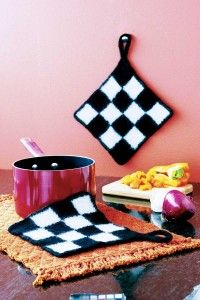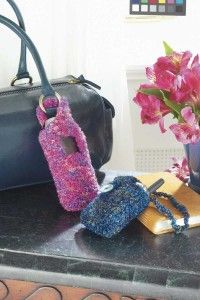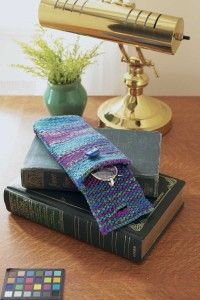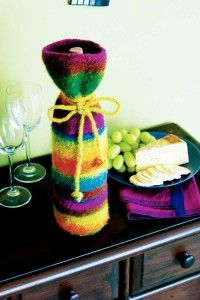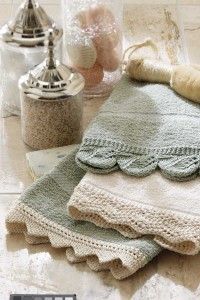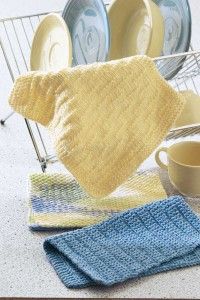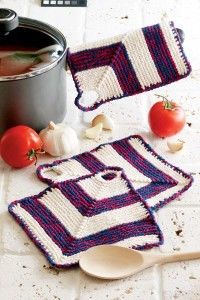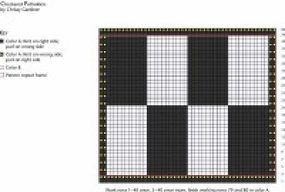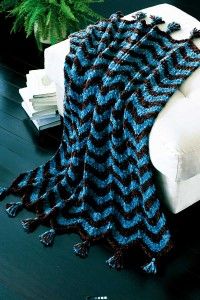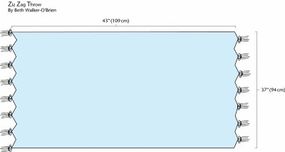Add simple knitted lace edging to everyday hand towels, and smile as guests admire your handiwork. These edgings are worked sideways after casting on a few stitches. Work the lace in any length, and apply to pillowcases, afghans, scarves, and more.
Techniques
Binding off -- BO
Blocking
Casting on - CO
Knit in front and back of same stitch - k1f&b
Knit 2 together -- k2tog
Purl 2 together -- p2tog
Slip slip knit decrease -- ssk
Weaving in yarn tails
Yarn over -- yo
Gauge
Natural edging on sage towel: 24 stitches/36 rows=4" (10cm) in pattern
Natural edging on natural towel: 24 stitches/38 rows=4" (10cm) in pattern
Sage edging on natural towel: 24 stitches/32 rows=4" (10cm) in pattern
What You'll Need
Yarn: 50 yards (46m) sport weight 100% cotton (natural edging on sage towel); 70 yards (63.7m) sport weight 100% cotton (natural edging on natural towel); 70 yards (63.7m) sport weight 100% cotton (sage edging on natural towel)
We used: Needful Yarns Lana Gatto Skipper (100% cotton): #124 natural, 1 ball each for natural edging on natural towel and natural edging on sage towel; #123 sage, 1 ball
Needles: US size 2 (2.75mm)
Notions: Tapestry needle; long pins with large heads; sewing needle and thread to match
Miscellaneous: 16x24 inches (40.5X61cm) hand towel, or desired size
Natural-color Edging on Sage Towel
Cast on 8 stitches.
Row 1: Knit 3, yarn over, knit 2 together, yarn over, knit 3. (9 stitches)
Rows 2, 4, 6, 8, and 10: Knit.
Row 3: Knit 3, yarn over, knit 2 together, yarn over, knit 4. (10 stitches)
Row 5: Knit 3, yarn over, knit 2 together, yarn over, knit 5. (11 stitches)
Row 7: Knit 3, yarn over, knit 2 together, yarn over, knit 6. (12 stitches)
Row 9: Knit 3, yarn over, knit 2 together, yarn over, knit 7. (13 stitches)
Row 11: Knit 3, yarn over, knit 2 together, yarn over, knit 8. (14 stitches)
Row 12: Bind off 6 stitches, knit to the end of the row. (8 stitches)
Repeat rows 1-12 for pattern. Continue in pattern until the edging, when slightly stretched, fits across bottom edge of towel. Complete edging, binding off all stitches at row 12.
Natural-color Edging on Natural Towel
Cast on 12 stitches.
Row 1: Knit 4, yarn over, knit 2 together, knit 2, yarn over, knit 2 together, yarn over, knit 2. (13 stitches)
Row 2: Yarn over, knit 2 together, knit 11.
Row 3: Knit 3, [yarn over, knit 2 together] 2 times, knit 2, yarn over, knit 2 together, yarn over, knit 2. (14 stitches)
Row 4: Yarn over, knit 2 together, knit 12.
Row 5: Knit 4, [yarn over, knit 2 together] 2 times, knit 2, yarn over, knit 2 together, yarn over, knit 2. (15 stitches)
Row 6: Yarn over, knit 2 together, knit 13.
Row 7: Knit 3, [yarn over, knit 2 together] 3 times, knit 2, yarn over, knit 2 together, yarn over, knit 2. (16 stitches)
Row 8: Yarn over, knit 2 together, knit 14.
Row 9: Knit 3, [knit 2 together, yarn over] 2 times, knit 2, knit 2 together, [yarn over, knit 2 together] 2 times, knit 1. (15 stitches)
Row 10: Yarn over, knit 2 together, knit 13.
Row 11: Knit 2, [knit 2 together, yarn over] 2 times, knit 2, knit 2 together, [yarn over, knit 2 together] 2 times, knit 1. (14 stitches)
Row 12: Yarn over, knit 2 together, knit 12.
Row 13: Knit 3, knit 2 together, yarn over, knit 2, knit 2 together, [yarn over, knit 2 together] 2 times, knit 1. (13 stitches)
Row 14: Yarn over, knit 2 together, knit 11.
Row 15: Knit 2, knit 2 together, yarn over, knit 2, knit 2 together, [yarn over, knit 2 together] 2 times, knit 1. (12 stitches)
Row 16: Yarn over, knit 2 together, knit 10.
Repeat rows 1-16 for pattern. Continue in pattern until the piece, when slightly stretched, fits across bottom edge of towel.
Complete edging, working row 16 of pattern repeat as follows: Yarn over, knit 2 together, bind off 1 stitch (this will be the yarn over the stitch remaining from the decrease), *knit 1, bind off 1 stitch**. Repeat from * to ** to end of row. See Finishing, below.
Sage-color Edging on Sage Towel
Cast on 8 stitches.
Row 1: Knit 5, yarn over, knit 1, yarn over, knit 2. (10 stitches)
Row 2: Purl 6, increase in next stitch by knitting into front and back loops, knit 3. (11 stitches)
Row 3: Knit 4, purl 1, knit 2, yarn over, knit 1, yarn over, knit 3. (13 stitches)
Row 4: Purl 8, knit 1 front and back, knit 4. (14 stitches)
Row 5: Knit 4, purl 2, knit 3, yarn over, knit 1, yarn over, knit 4. (16 stitches)
Row 6: Purl 10, knit 1 front and back, knit 5. (17 stitches)
Row 7: Knit 4, purl 3, knit 4, yarn over, knit 1, yarn over, knit 5. (19 stitches)
Row 8: Purl 12, knit 1 front and back, knit 6. (20 stitches)
Row 9: Knit 4, purl 4, slip slip knit, knit 7, knit 2 together, knit 1. (18 stitches)
Row 10: Purl 10, knit 1 front and back, knit 7. (19 stitches)
Row 11: Knit 4, purl 5, slip slip knit, knit 5, knit 2 together, knit 1. (17 stitches)
Row 12: Purl 8, knit 1 front and back, knit 2, purl 1, knit 5. (18 stitches)
Row 13: Knit 4, purl 1, knit 1, purl 4, slip slip knit, knit 3, knit 2 together, knit 1. (16 stitches)
Row 14: Purl 6, knit 1 front and back, knit 3, purl 1, knit 5. (17 stitches)
Row 15: Knit 4, purl 1, knit 1, purl 5, slip slip knit, knit 1, knit 2 together, knit 1. (15 stitches)
Row 16: Purl 4, knit 1 front and back, knit 4, purl 1, knit 5. (16 stitches)
Row 17: Knit 4, purl 1, knit 1, purl 6, slip 1 knitwise, knit 2 together, pass slipped stitch over, knit 1. (14 stitches)
Row 18: Purl 2 together, bind off 5 stitches, purl 3, knit 4. (8 stitches)
Repeat row 1-18 for pattern. Work in pattern until the piece, when slightly stretched, fits across bottom edge of towel. Complete edging, binding off all stitches in pattern at row 18. See Finishing, below.
Finishing the Towels
Weave in all yarn tails to wrong side of work. Block. Pin edging to 1 end of towel; thread sewing needle with matching thread, and attach edging to towel with overcast stitch. Remove all pins.
Go to the next page for another style of towels that you can easily learn to knit: Designer dishtowels.
